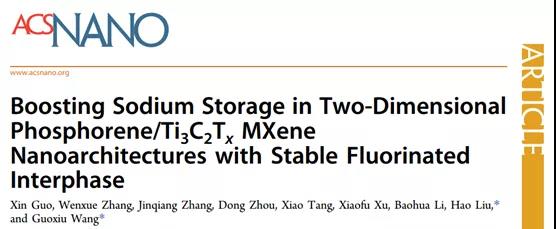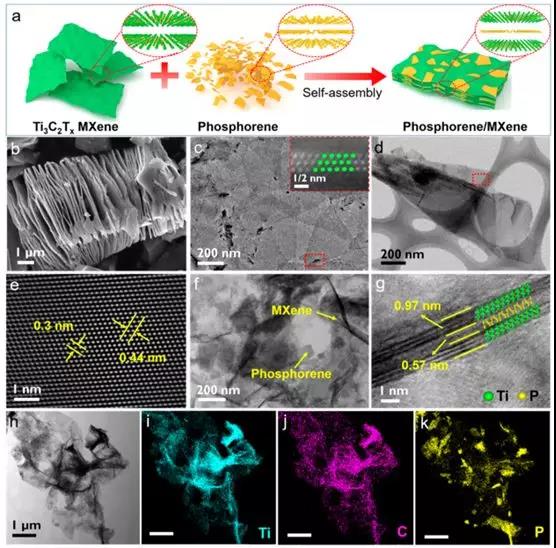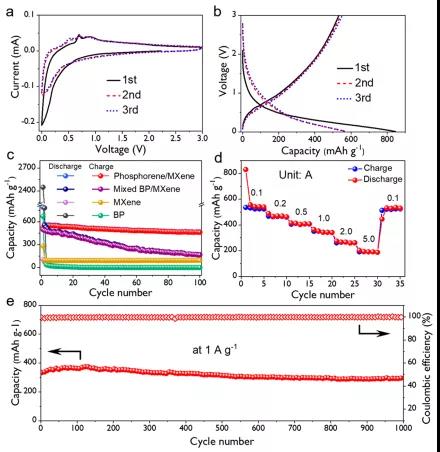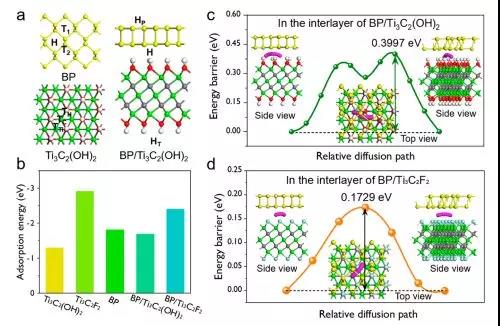

¡¾Research Background¡¿
Sodium ion batteries (SIBs) are an emerging alternative rechargeable battery system due to their lower cost, rich sodium reserves, and intercalation chemistry similar to lithium ion batteries. However, for general electrode materials, Na + ¡®s larger ionic radius not only restricts its movement but also causes severe structural expansion. Among the many sodium storage electrode materials, phosphorus (P) is based on the alloying reaction: 3Na + P ⇌ Na 3 P and therefore has the highest theoretical capacity: ~ 2600 mAh g -1 . There are three main forms of allotropic phosphorus, including white phosphorus, red phosphorus and black phosphorus. In general, white phosphorus has the highest reactivity but is also fatal to human body, so it is not suitable as an electrode material. Red phosphorus has been widely studied as a sodium electric anode material, and its low intrinsic conductivity and low ion diffusion rate limit fast charge and discharge performance and cycle life when applied to batteries. Black phosphorus is the most thermodynamically stable and most conductive allotrope. In particular, bulk black phosphorus can be stripped into 2D layered nanosheets (known as phosphene), which takes advantage of 2D structural materials for energy storage, such as shorter ion diffusion paths and larger area volume. Ratio and more active sites. However, like most 2D materials, phosphene will also experience severe restacking problems. In addition, the large volume expansion caused during alloying and dealloying will destroy the electrode structure of the phosphene and affect battery performance. .
In order to solve the above problems, compounding other complementary 2D materials is an effective way. MXenes is an emerging 2D layered transition metal carbide / nitride with high electrical conductivity, good elasticity and super high hydrophilicity. MXenes¡® outstanding electrical conductivity makes electrons and alkali metal ions an ideal complementary material for semiconductor or non-conductive electrode materials (such as metal oxides, silicon, phosphorus). Therefore, compounding phosphorene with 2D MXene nanosheets is an effective way to solve the serious restacking problem.
[Achievement Profile]
Recently, the Sydney University of Technology, Professor Wang Guoxiu and Hao Professor Liu cooperation , well-known in the international academic journal ACS Nano publication title on is: Boosting Sodium Storage in Two-Dimensional phosphorene / Ti 3 C 2 T the X- MXene Nanoarchitectures with Stable Fluorinated Interphase research papers . In this paper, the black phosphorus / MXene composite negative electrode can stably and quickly store sodium by forming a fluorinated interface in situ .Alkenyl and phosphorus nanosheet of Ti . 3 C 2 T X MXene composite not only facilitate the transfer of electrons and sodium ions, it is possible to limit expansion of the structure, thereby improving the cycle properties of the composite electrode, A G 0.1 -1 at a current density of up to With a reversible capacity of 535 mAh g -1 , at the same time, under a high current density of 1 A g -1 , after 1000 charge and discharge cycles, 87% of the initial capacity can be retained.
[Picture and text guide]

Figure 1. Schematic diagram of the synthesis process and micro-morphological characterization of composite electrodes: SEM, TEM, HRTEM, STEM, and mapping.

Figure 2. XRD, Raman, and XPS spectra of the composite electrode and comparative samples.

Figure 3. Electrochemical performance testing of composite electrodes: CV, GCD, cycle stability, rate performance, and cycle performance at high current density.

Figure 4. In- depth XPS analysis and AC impedance plots of composite electrodes.

Figure 5. Theoretical calculations of sodium adsorption and diffusion for composite electrodes and comparative samples.
[Summary of this article]
In summary, this paper uses a composite of Ti 3 C 2 T x with high conductivity and a high-capacity phosphene as the anode material of a high-performance sodium ion battery. Experimental investigations and theoretical calculations prove that Ti 3 C 2 T x MXene can not only buffer the volume expansion of phosphene, but also promote the diffusion of sodium ions in the 2D heterostructure. In addition, in-depth XPS analysis of the cycling electrode showed that the fluoro-functional groups of MXene formed a fluorine-rich SEI membrane, which stabilized cycling performance and improved Coulomb efficiency. It is proved that inorganic 2D materials with functional groups can effectively regulate the SEI film and promote the electrochemical performance of the battery.
Literature link:
https://dx.doi.org/10.1021/acsnano.0c00177
Source: MXene Frontier










